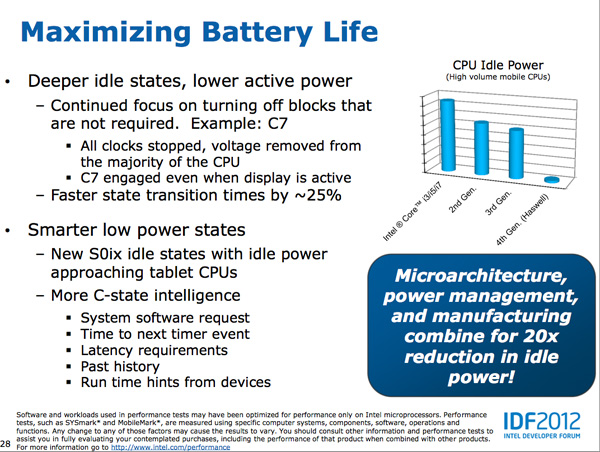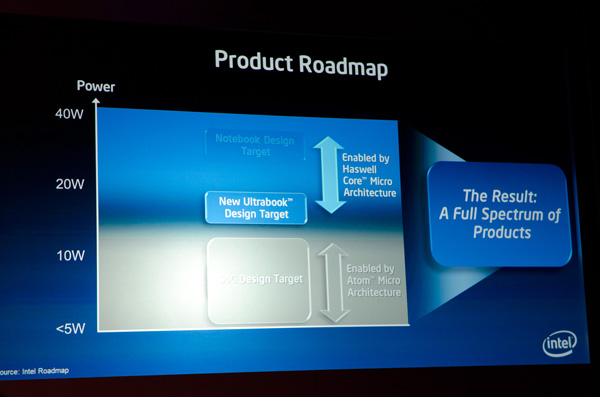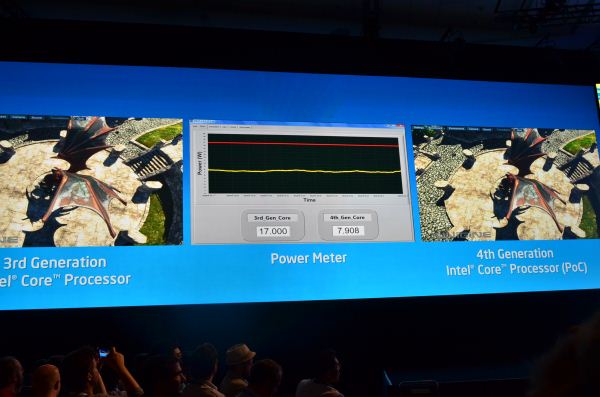Intel's Haswell Architecture Analyzed: Building a New PC and a New Intel
by Anand Lal Shimpi on October 5, 2012 2:45 AM ESTOther Power Savings
Haswell's power savings come from three sources, all of which are equally important. We already went over the most unique: Intel's focus on reducing total platform power consumption by paying attention to everything else on the motherboard (third party controllers, voltage regulation, etc...). The other two sources of power savings are more traditional, but still very significant.

At the micro-architecture level Intel added more power gating and low power modes to Haswell. The additional power gating gives the power control unit (PCU) more fine grained control over shutting off parts of the core that aren't used. Intel published a relatively meaningless graph showing idle power for standard voltage mobile Haswell compared to the previous three generations of Core processors.
Haswell can also transition between power states approximately 25% faster than Ivy Bridge, which lets the PCU be a bit more aggressive in which power state it selects since the penalty of coming out of it is appreciably lower. It's important to put the timing of all of this in perspective. Putting the CPU cores to sleep and removing voltage/power from them even for a matter of milliseconds adds up to the sort of savings necessary to really enable the sort of always-on, always-connected behavior Haswell based systems are expected to deliver.
Intel has also done a lot of work at the process level to bring Haswell's power consumption down. As a tock, Haswell is the second micro-architecture to use Intel's new 22nm tri-gate transistors. The learnings from Ivy Bridge are thus all poured into Haswell. Intel wasn't too specific on what it did on the manufacturing side to help drive power down in Haswell other than to say that a non-insignificant amount of work came from the fabs.
The Fourth Haswell
At Computex Intel's Mooly Eden showed off this slide that positioned Haswell as a 15-20W part, while Atom based SoCs would scale up to 10W and perhaps beyond:
Just before this year's IDF Intel claimed that Haswell ULT would start at 10W, down from 17W in Sandy/Ivy Bridge. Finally, at IDF Intel showed a demo of Haswell running the Unigen Heaven benchmark at under 8W:
The chain of events tells us two things: 1) Intel likes to play its cards close to its chest, and 2) the sub-10W space won't be serviced by Atom exclusively.
Intel said Haswell can scale below 10W, but it didn't provide a lower bound. It's too much to assume Haswell would go into a phone, but once you get to the 8W point and look south you open yourself up to fitting into things the size of a third generation iPad. Move to 14nm, 10nm and beyond then it becomes more feasible that you could fit this class of architecture into something even more portable.
Intel is being very tight lipped about the fourth client Haswell (remember the first three were desktop, mobile and ultra-low-volt/Ultrabook) but it's clear that it has real aspirations to use it in a space traditionally reserved for ARM or Atom SoCs.
One of the first things I ever heard about Haswell was that it was Intel's solution to the ARM problem. I don't believe a 10W notebook is going to do anything to the ARM problem, but a sub-8W Haswell in an iPad 3 form factor could be very compelling. Haswell won't be fanless, but Broadwell (14nm) could be. And that could be a real solution to the ARM problem, at least outside of a phone.
As I said before, I don't see Haswell making it into a phone but that's not to say a future derivative on a lower power process wouldn't.













245 Comments
View All Comments
Anand Lal Shimpi - Friday, October 5, 2012 - link
It's the other way around: not talking about Apple using Intel in iPads, but rather Apple ditching Intel in the MacBook Air.I do agree with Charlie in that there's a lot of pressure within Apple to move more designs away from Intel and to something home grown. I suspect what we'll see is the introduction of new ARM based form factors that might slowly shift revenue away from the traditional Macs rather than something as simple as dropping an Ax SoC in a MacBook Air.
Take care,
Anand
A5 - Friday, October 5, 2012 - link
Yeah. I knew what you were getting at, but I guess it wasn't that obvious for some people :-p.Something like an iPad 3 with an Apple-made keyboard case + some changes in iOS would make Intel and notebook OEMs really scared.
tipoo - Friday, October 5, 2012 - link
So pretty much the Surface tablet. The keyboard case looks amazing, can't wait to try one.Kevin G - Friday, October 5, 2012 - link
Apple is in the unique position that they could go with either platform way. They are capable of moving iOS to x86 or OS X to ARM on seemingly a whim. Their decision would be dictated not by current and chips arriving in the short term (Haswell and the Cortex A15) but rather long term road maps. Apple would be willing ditch their own CPU design if it brought a clear power, performance and process advantage from what they could do themselves. The reason why Apple manufactured an ARM chip themselves is that they couldn't get the power and performance out of SoC's from other companies.The message Intel wants to send to Apple is that Haswell (and then Broadwell) can compete in the ultra mobile market. Intel also knows the risk to them if Apple sticks to ARM: Apple is the dominate player in the tablet market and one of the major players in the cell phone market and pretty much the only success in the utlrabook segment. Apple's success is eating away the PC market which is Intel's bread and butter in x86 chip sales. So for the moment Intel is actively promoting Apple's competitors in the ultrabook segment and assist in 10W Ivy Bridge and 10W Haswell tablet designs.
If Intel can't get anyone to beat Apple, they might as well join them over the long run. This would also explain Intel toying with the idea of becoming a foundry. If Intel doesn't get their x86 chips into the iPad/iPhone, they might as well manufacture the ARM chips that do. Apple is also one of the few companies who would be willing to pay a premium for Intel foundry access (and the extra ARM not x86 premium).
So there are four scenarios that could play out in the long term: the status quo of x86 for OS X + ARM for iOS, x86 for both OS X + iOS, ARM for both OS X + iOS and ARM built by Intel for OS X + iOS.
Peanutsrevenge - Friday, October 5, 2012 - link
I will LMAO if Apple switch macs back to RISC in the next few years.Will be RISC, x86, RISC in the space of a decade.
Poor Crapple users having to keep swapping their software.
I laughed 6 ago, and I'll laugh again :D
Kevin G - Saturday, October 6, 2012 - link
But it wouldn't be the same RISC. ARM isn't PowerPC.And hey, Apple did go from CISC to RISC to back to CISC again for their Macs.
Penti - Saturday, October 6, 2012 - link
They hardly would want to be in the situation where they have to compete with Intel and Intel's performance again. Also their PC/Mac lineup is just so much smaller then the mobile market they have, why would they create teams of thousands of engineers (which they don't have) to create workstation processors for their mobile workstations and mac pro's? They couldn't really do that with PowerPC design despite having influence on chip architecture, they lost out in the race and just grows more dependent on other external suppliers and those Macs would loose the ability to run Boot camp'd or virtualized Windows. It's not the same x86 as it was in 2006 either.A switch would turn Macs into toys rather then creative and engineering tools. It would create an disadvantage with all the tools developed for x86 and if they drop high-end they might as well turn themselves into an mobile computing company and port their development tools to Windows. As it's not like they will replace all the client and server systems in the world or even aspire to.
I don't have anything against ARM creping into desktops. But they really has no reason to segment their system into ARM or x86. It's much easier to keep the iOS vs OS X divide.
Haswell will give you ARM or Atom (Z2760) battery life for just some hundred dollars more or so. If they can support the software better those machine will be loaded with software worth thousands of dollar per machine/user any way. Were the weaker machines simply can't run most of that. Casual users can still go with Atom if they want something weaker/cheaper or another ecosystem altogether.
Kevin G - Monday, October 8, 2012 - link
The market is less about performance now as even taking a few steps backward a user has a 'good enough' performance. It is about gaining mobility which is driven by reduction in power consumption.Would Apple want to compete with Intel's Xeon's line up? No and well, Apple isn't even trying to stay on the cutting edge there (their Mac Pro's are essentially a 3 year old design with moderate processor speed bumps in 2010 and 2012). If Apple was serious about performance here, they'd have a dual LGA 2011 Xeon as their flagship system. The creative and engineering types have been eager for such a system which Apple has effectively told them to look elsewhere for such a workstation.
With regards to virtualization, yes it would be a step backward not to be able to run x86 based VM's but ARM has defined their own VM extensions. So while OS X would lose the ability to host x86 based Windows VM's, their ARM hardware could native run OS X with an iOS guest, an Android guest or a Windows RT guest. There is also brute force emulation to get the job done if need be.
Moving to pure ARM is a valid path for iOS and OS X is a valid path for Apple though it is not their only long term option.
Penti - Tuesday, October 9, 2012 - link
You will not be able to license Windows RT at all as an end-user. Apple has no interest what so ever to support GNU/Linux based ARM-VMs.I'm sure they will update the Mac Pro the reason behind it is largely thanks to Intel themselves. That's not their only workstation though, and yes performance is important in the mobile (notebook space), performance per watt is really important too. If they want mobile workstations and engineering type machines they won't go with ARM. As it does mean they would have to compete with Intel. They could buy a firm with an x86 license and outdo Intel if they were really capable of that. ISA doesn't really matter here expect when it comes to tools.
baba264 - Friday, October 5, 2012 - link
"Within 8 years many expect all mainstream computing to move to smartphones, or whatever other ultra portable form factor computing device we're carrying around at that point."I don't know if I am in a minority or what, but I really don't see myself giving up my desktop anytime soon. I love my mechanical keyboard my large screen and my computing power. So I have to wander if I'm just an edge case or if analyst are reading too much in the rise of the smartphone.
Great article otherwise :).